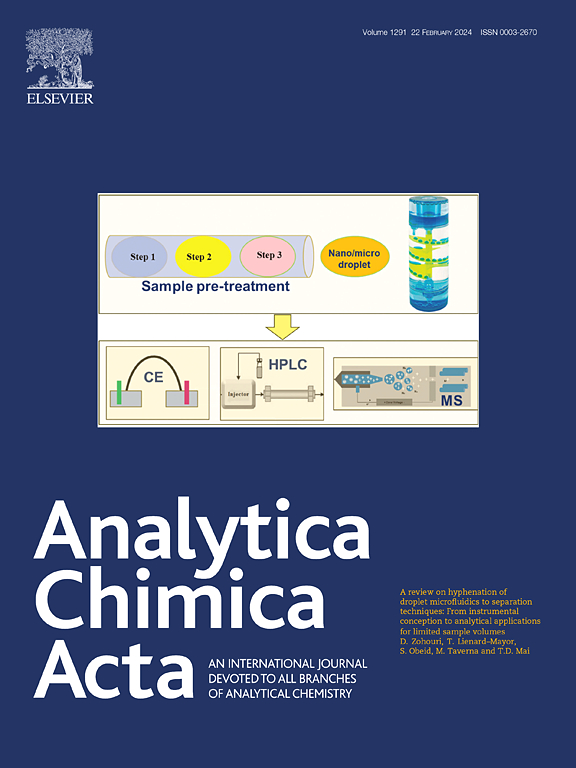Qualitative and quantitative analysis of highly-polar contaminants in Atlanta urban water
IF 5.7
2区 化学
Q1 CHEMISTRY, ANALYTICAL
引用次数: 0
Abstract
Background
Highly polar substances have fallen from the scope of investigations due to this lack of accumulation into organic materials and the analytical difficulty they present using “traditional” techniques. This study presents an integrated analytical approach combining liquid chromatography (LC) and travelling-wave ion mobility spectrometry (TWIMS) coupled with high-resolution mass spectrometry (HRMS) for the separation, detection, and quantification of 45 challenging contaminants in urban water matrices. The targeted analytes, including 41 very mobile compounds and 37 highly polar substances (log Dow < 0), represent compounds that are often poorly retained under conventional reversed-phase and HILIC LC conditions.
Results
TWIMS was used to determine the CCS of 33 small organic molecules (120–500 Da). A ΔCCS threshold of ≥0.5 % was identified as sufficient for proper separation on second-generation IMS instruments (resolving power >300 Rp). In cases where LC provided inadequate retention, TWIMS proved to be an effective complementary technique by exploiting differences in molecular size, shape, and charge to resolve compounds based on their collision cross-section (CCS) values.
Surface water samples from the Chattahoochee River and tap water from Midtown Atlanta (USA) were analyzed, revealing that over 50 % of the targeted contaminants were detected in at least one matrix. Notably, compounds such as naphthalene-1-sulfonic acid, nicotine, and several per- and poly-fluoroalkyl substances (PFAS) were consistently observed, highlighting their ubiquitous occurrence in urban water impacted by industrial activities and heavy traffic.
Significance
The methodology employed not only improved the resolution and identification of small, highly polar molecules but also provided robust quantitative data essential for environmental monitoring and risk assessment. This approach underscores the potential of IMS as a valuable complementary tool to traditional LC-MS workflows in complex environmental analyses. Additionally, the data presented regarding the presence of highly polar substances in urban water matrices should inform stakeholders and implement preventive strategies.


亚特兰大城市水中高极性污染物的定性和定量分析
高极性物质已经从研究范围中消失了,因为它们在有机物质中缺乏积累,而且使用“传统”技术分析它们存在困难。本研究提出了一种结合液相色谱(LC)、行波离子迁移率光谱(TWIMS)和高分辨率质谱(HRMS)的综合分析方法,用于分离、检测和定量城市水基质中45种具有挑战性的污染物。目标分析物,包括41种非常流动的化合物和37种高极性物质(log Dow <;0),代表在常规反相和HILIC LC条件下通常保留不良的化合物。结果采用stwims法测定了33个有机小分子(120 ~ 500 Da)的碳捕集量。ΔCCS阈值≥0.5%被认为足以在第二代IMS仪器上进行适当的分离(分辨率>;300 Rp)。在LC不能提供充分保留的情况下,TWIMS被证明是一种有效的补充技术,它利用分子大小、形状和电荷的差异,根据它们的碰撞截面(CCS)值来解析化合物。研究人员分析了查塔胡奇河的地表水样本和美国亚特兰大市中心的自来水样本,发现至少有一种基质中检测到超过50%的目标污染物。值得注意的是,持续观察到萘-1-磺酸、尼古丁以及几种单氟烷基和多氟烷基物质(PFAS)等化合物,突出表明它们在受工业活动和繁忙交通影响的城市水中普遍存在。所采用的方法不仅提高了高极性小分子的分辨率和识别能力,而且为环境监测和风险评估提供了可靠的定量数据。这种方法强调了IMS在复杂环境分析中作为传统LC-MS工作流程有价值的补充工具的潜力。此外,所提供的关于城市水基质中存在高极性物质的数据应告知利益相关者并实施预防战略。
本文章由计算机程序翻译,如有差异,请以英文原文为准。
求助全文
约1分钟内获得全文
求助全文
来源期刊

Analytica Chimica Acta
化学-分析化学
CiteScore
10.40
自引率
6.50%
发文量
1081
审稿时长
38 days
期刊介绍:
Analytica Chimica Acta has an open access mirror journal Analytica Chimica Acta: X, sharing the same aims and scope, editorial team, submission system and rigorous peer review.
Analytica Chimica Acta provides a forum for the rapid publication of original research, and critical, comprehensive reviews dealing with all aspects of fundamental and applied modern analytical chemistry. The journal welcomes the submission of research papers which report studies concerning the development of new and significant analytical methodologies. In determining the suitability of submitted articles for publication, particular scrutiny will be placed on the degree of novelty and impact of the research and the extent to which it adds to the existing body of knowledge in analytical chemistry.
 求助内容:
求助内容: 应助结果提醒方式:
应助结果提醒方式:


